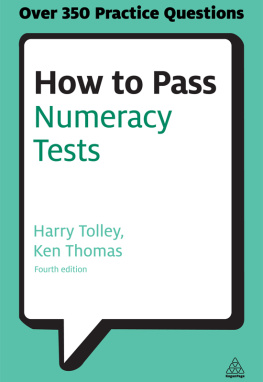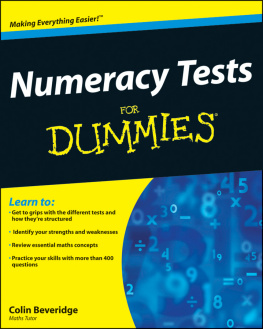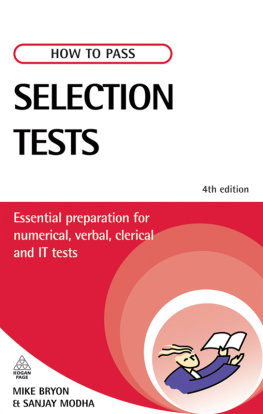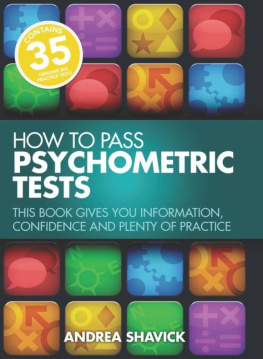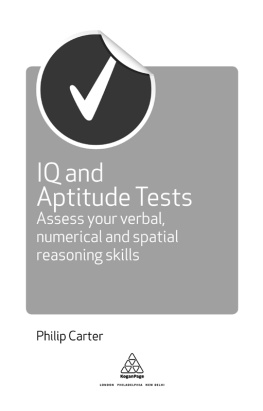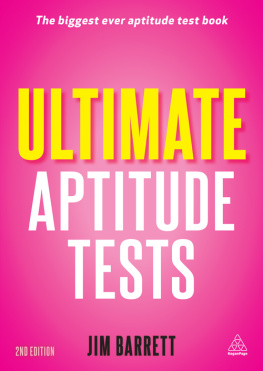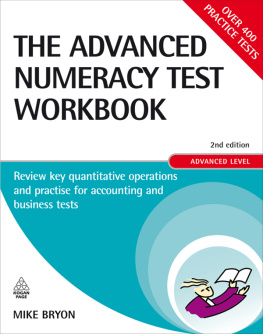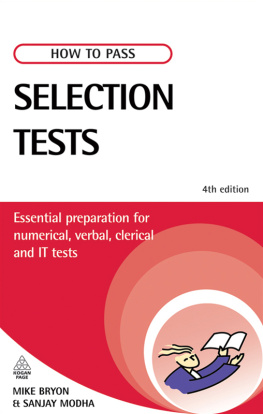Note on the Ebook Edition For an optimal reading experience, please view large
tables and figures in landscape mode. |
This ebook published in 2012 by Kogan Page Limited 120 Pentonville Road London N1 9JN UK www.koganpage.com Heidi Smith 2003, 2006, 2011, 2013 E-ISBN 9780749467982 This book is dedicated to Dr J V Armitage Contents T he success of the First Edition of How to Pass Numerical Reasoning Tests demonstrates that there are many people who, despite a high level of experience and competence in other areas of their professional life, are not confident about passing tests that involve numbers. However, what is not commonly known is that with practice it is possible to improve your numerical reasoning score dramatically. This book was designed with the adult test-taker in mind someone who is looking for some extra practice material prior to taking a test. Topics covered include: percentages what are the three parts I have to know in order to work out the answer? decimals what was that quick way to multiply them? workrates wasnt there something about adding the total time together and dividing by something? prime numbers and multiples I remember I can use these to help me, but cant quite remember how interest rates what were the two different types and how do I use each of them?. This workbook reminds the non-mathematician what these terms are and how to work with them quickly.
The First Edition of How to Pass Numerical Reasoning Tests has helped thousands of applicants prepare for their test. This Second Edition will help many more. Better preparation for psychometric testing leads to increased confidence during the initial assessment and this, undoubtedly, gives you a better chance of getting that job. Numerical reasoning tests in context Standardized testing is becoming more popular as a means to assess candidates at an early stage of the job application process, particularly in organizations where the demand for jobs is high. If you have picked up this book and started to read this chapter, the chances are that you are facing a numerical reasoning test in the very near future. It is likely that you know that you are perfectly capable of doing the job for which you have applied, and that the only obstacle between you and the next round of interviews is a set of tests that includes a numerical reasoning section.
It is possible that you are dreading it. Not many people like being tested under pressure, so it is unsurprising that you are not looking forward to the experience. Take heart though. The good news is that the numerical knowledge you need to do well in these tests is the maths you learnt in school. You need now a quick refresher course and the application of some logical thinking. With practice and commitment to drilling in mental arithmetic you can improve your score.
The numerical reasoning section of an aptitude test is the section where many people find they can improve their score, so its worth dedicating a decent amount of test preparation time to this area. Purpose of this workbook This is a self-study modular workbook, and its purpose is to provide you with the necessary skills to perform well in your numerical reasoning test. There is no magic formula for improving your performance in numerical reasoning tests; however, performance is determined by a number of factors aside from basic intelligence. Preparation plays a large part in determining your level of success, and the secret is to practise as much as you can. If the last time you had to work out a percentage increase was a decade ago, it is likely that a quick reminder of the method will help you complete the calculation within the time allowed in the test. This workbook will explain these formulae to remind you how to complete such calculations.
Test preparation and good exam technique gives you the confidence to estimate correct answers quickly. Method and practice will help you to calculate correct answers swiftly. This book will help you to prepare for your test by giving you plenty of examples, practice questions and explanations. What this workbook doesnt do The content of this workbook is aimed at adult test-takers who want to prepare to take a numerical reasoning test. It is assumed that you dont necessarily want, or have time, to become a mathematician, but you do want to relearn enough maths to help you to do well in the test. This workbook is designed to help you to prepare the required numeracy skills for the standardized aptitude tests currently on the market.
This workbook will not explain why mathematical formulae work the way they do. Rather, it explains how to apply the formula in a practical setting, in particular in the application of maths in numeracy tests. It is likely that if you wanted to understand the theory of maths, you would be already immersed in advanced level maths books and wouldnt need this refresher course. Content of this workbook Each chapter first explains the concept, works through an example and provides you with practice questions to help consolidate your learning. The emphasis throughout the book is on the practice questions and corresponding explanations. , Fractions and decimals, explains how to work with parts of whole numbers expressed either as fractions or decimals. , Fractions and decimals, explains how to work with parts of whole numbers expressed either as fractions or decimals.
You will practise the methods to add, subtract, multiply and divide fractions and decimals. , Rates, reminds you of the formulae to work out speed, distance and time when you know two (or more) variables. This chapter also covers the work rate formula. , Percentages, covers the three variables in a typical percentage question. The part, the whole and the percentage are all explained. , Ratios and proportions, examines part to part and part to whole type ratios and explains how to use ratios to find actual quantities. , Ratios and proportions, examines part to part and part to whole type ratios and explains how to use ratios to find actual quantities.
An explanation of the use of proportions is included . , Data interpretation, takes all the skills you have practised and combines them to allow you to practise applying your new skills to data presented in graphs, tables and charts. , Word problems, is brand new to this edition and shows how your analytical skills are under scrutiny just as much as your numerical skills when you are presented with a word problem. The Glossary of terms and formulae section lists all the terms and formulae you have used throughout the book and serves as a reference guide. The Recommendations for further practice section identifies a number of useful publications and websites for you to use for further practice prior to your test. In each chapter, an explanation is offered to solve each of the problems.
Often there are several different ways to solve a problem. You may find that your preferred method differs from the explanation offered. As you work through more and more examples, you will discover the methods you find easiest to work with, so do try other methods, either to check your answer, or to find out whether there is a quicker way to solve the problem. Remember that speed is a key indicator of success. How to use this workbook This workbook is designed to teach the foundation skills relevant to a number of numerical reasoning tests currently on the market. It is progressive and you should work through each of the chapters in order.
Concepts explained in the earlier chapters are used and tested again in later chapters. It is good practice for employers and recruiters to send you sample questions prior to the test, in order that you know what to expect on the day. Once you know the broad content of the test, you can use this workbook to practise the areas most relevant to you if time is short. It is recommended that you work thoroughly through provides you with the skills to build a numerical foundation relevant to subsequent chapters. Preparation and test technique Being prepared for the test If you dont know what kind of questions to expect in your test, there are two things you can do. First, call the tester or recruiter and ask for a sample practice booklet.





